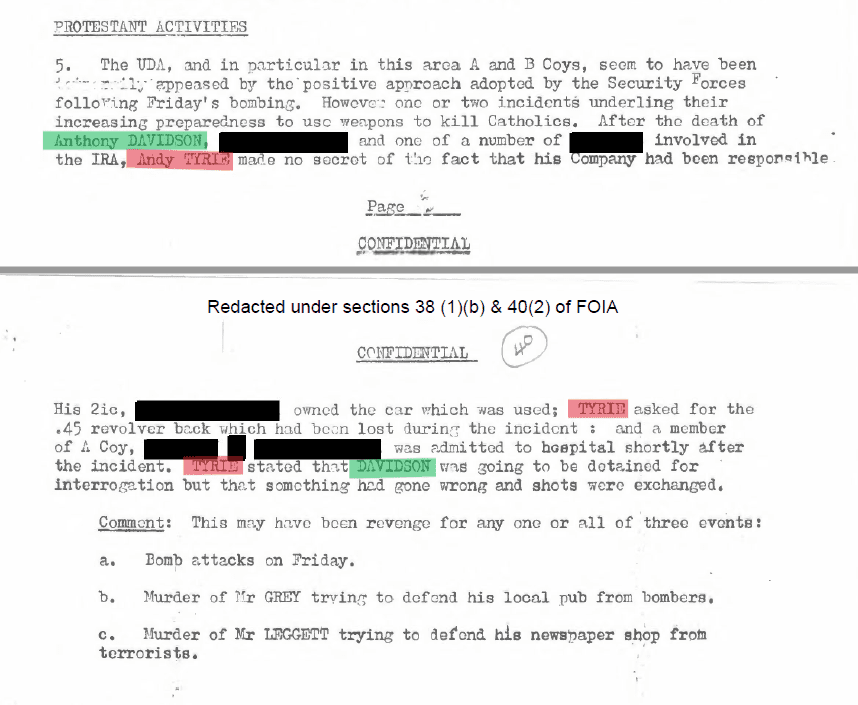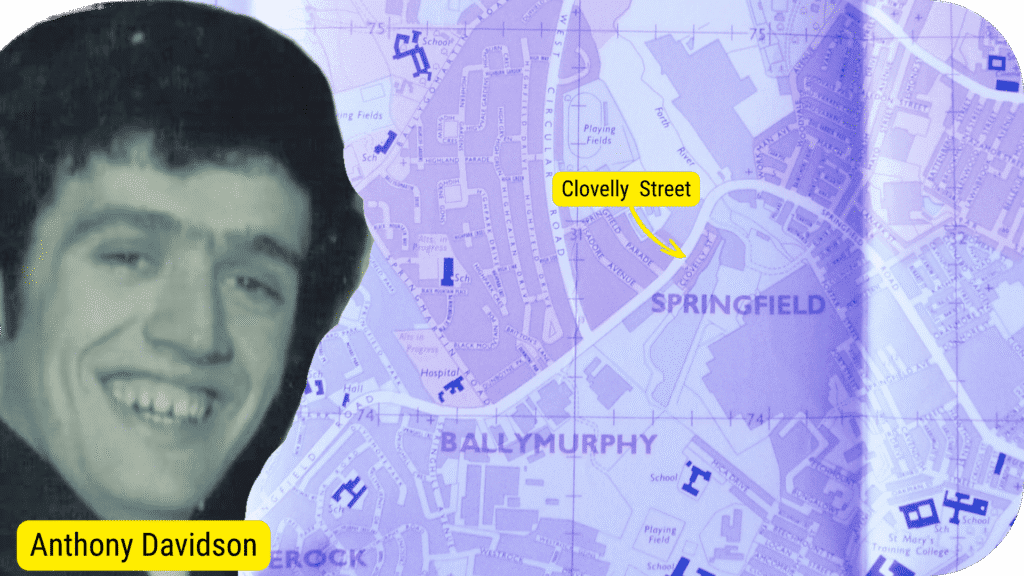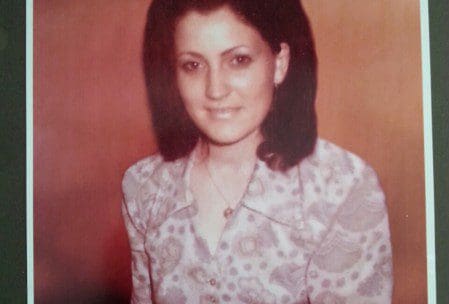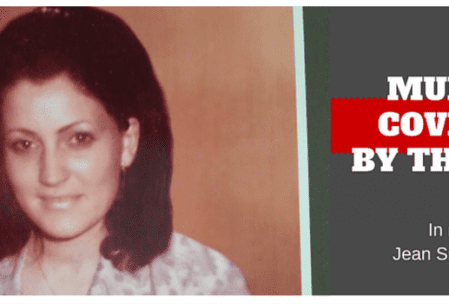The 1972 murder of a young, married father of two, Anthony Davidson, lays bare British state collusion with Andy Tyrie, Loyalist paramilitary leader.
Secret British Army files from the bloodiest month of the conflict prove that Andy Tyrie, the Supreme Commander of the Ulster Defence Association for 15 years, was a British state agent. In these files that Paper Trail has tracked and fought for over the last 9 years, Tyrie admitted his men's involvement in several murders, including the murder of Anthony Davidson, told the authorities the names of his men involved, and even asked for the return of a gun which the UDA killers had dropped at the murder scene.
Anthony Davidson was shot and mortally wounded when he opened the door of his home in Clovelly Street, Springfield Road, West Belfast, just past midnight on 21st July 1972.
His young widow, Annie, told the inquest in August 1973 that she was threatened by three men on the Springfield Road that day: "We will get all you Fenians out of the street and your husband will be the first to go."
That night, somebody rang the front doorbell, and a man gave the name of a family friend. Anthony and his wife did not recognise his voice. He told Annie to move out of the hallway and into a room before opening the door. Annie told the Coroner she saw the barrel of a gun and then there were shots, with Anthony shot in the head. A neighbour saw a man running away and trying to get into a moving car, but the car drove on without him.
Reports of the Shooting
The 1st Battalion King’s Regiment (1 Kings), occupying that part of West Belfast, reported at 0018 hours (12:18 am):
“Shooting heard CLOVELLY ST, one man believed killed, SFNI [Security Forces Northern Ireland] RUC and KINGS investigating.”
Anthony was actually still clinging to life. He had bravely fought his attackers and had even managed to shoot one of them who dropped a .45 calibre pistol at the scene and escaped injured.
The Evening Herald reported that day that Anthony was a member of the Catholic Ex-Servicemen’s Association (CESA) and had only obtained a weapon for his personal protection the day before, following several other threats to his life in the weeks leading up to the attack. CESA members were prime targets for both Loyalist paramilitaries and the British Army in 1972-3, and this was recorded at the time in the media. Either that, or he had jostled the attacker's gun and injured the attacker.
The British Army recovered the killer’s gun and reported a description of two cars involved in the killing at 0045 hours (12:45 am):
“Mr A Davidson… seriously ill… Shot at doorstep of 48 by gunman who dropped .45 pistol, recovered, 2 cars involved, Red Mini, black saloon [CAR REG REDACTED] false plates…”
At 0227 hours (2:27 am), 1 Kings reported that Anthony Davidson had died.
An RUC spokesman told the Belfast Telegraph (21st July 1972):
“The circumstances of this incident are still a bit obscure and the matter is being investigated.”
Who were the killers, especially the one shot and injured at the scene? The police never brought anyone to justice for the murder, but police had actually found .45 bullets in the possession of a man who was shot and being treated near Anthony in the hospital. The RUC and British Army had even linked this injured man to Anthony's murder by the time he died.
Nevertheless, nobody ever faced justice for the murder, and it lay unclaimed until Paper Trail published its investigation today. It gets even worse.
Continued below...

New Evidence
Following a long information battles via the Freedom of Information Act, Paper Trail accessed secret British military archives relating to dozens of killings in July 1972. July 1972 was the bloodiest month of the conflict with 90 people killed and hundreds injured in the north of Ireland.
All sides contributed to the carnage.
Anthony’s killing followed the sectarian murder of two Protestant civilians in the area by Republicans and opened one of the most vicious days of the conflict too. That day, Bloody Friday, the IRA exploded over 20 bombs across Belfast, killing 9 people and injuring 130. The night ended with targeted and random killings by Loyalists, including the murder of Francis Arthurs.
Over many years since discovering these files and related archives, Paper Trail collated this historic information and offered any new evidence to families of victims and their legal teams. But it was not until the death of a leading Loyalist that we could fight to reveal the particular redaction of his name.
The evidence of blatant collusion in the cover-up of Anthony’s murder stunned us.
Paper Trail discovered significant, new evidence in a British military Intelligence Summary (INTSUM) dated 27th July 1972. This was then circulated to each British battalion stationed in the north of Ireland up to and including each Brigade Headquarters, Headquarters Northern Ireland, RUC Headquarters Knock and the Head of RUC Special Branch.
This detailed INTSUM was written at a time when Protestant extremists were yet to be interned and the British state denied the existence of organised Loyalist violence. The British state did not proscribe the UDA until 1992, of course.
Under “PROTESTANT ACTIVITIES”, the Intelligence Summary records:
“The UDA, and in particular A and B Coys [Companies], seem to have been temporarily appeased by the positive approach adopted by the Security Forces following Friday’s bombing. However, one or two incidents underline their increasing preparedness to use weapons to kill Catholics. After the death of Anthony DAVIDSON, [NAME REDACTED] and one of a number of brothers involved in the IRA, Andy TYRIE made no secret of the fact that his Company had been responsible. His 2ic [Second in Command], [LOYALIST 2IC NAMED] owned the car which was used; TYRIE asked for the .45 revolver back which had been lost during th incident; and a member of A Company [NAME, AGE ADRESS REDCATED] was admitted to hospital shortly after the incident. TYRIE stated that DAVIDSON was going to be detained for interrogation but that something had gone wrong and shots were exchanged.
Comment: This may have been revenge for any one or all of three events:
a. Bomb attacks on Friday.
b. Murder of Mr. GREY [sic] trying to defend his local pub from bombers.
c. Murder of Mr. LEGGETT trying to defend his newspaper shop from terrorists.”

Protestant civilians, Harold Gray and Leslie Leggett were shot dead during bomb attacks on Protestant property in the Springfield Road area. Leslie's wife, Mary, was shot in the same attack and bombing of their newsagency. The IRA were suspected of both killings. But (a) above, the "bomb attacks on Friday" apparently related to Bloody Friday which, of course, happened after the killing of Anthony.
British military INTSUMS from May 1972, which Paper Trail discovered in 2014, named the Loyalist leader of A Company (Highfield and Springmartin, West Belfast) and his Second in Command along with scores of other UDA leaders across Belfast. Their addresses are also given. These particular files are not redacted.
The Loyalist leader named in the May 1972 INTSUMs was Andy Tyrie who rose to be the UDA’s commander in 1973 but the Loyalist leader’s name was originally redacted in these files. Paper Trail had to wait until his death to prove that it was Tyrie who was divulging so much information relating to murders and murderers in the area perpetrated by his units.
As in many other terrible cases investigated by Paper Trail, such as the murder of teenager Ciarán Murphy, Loyalist killers did not even bother to steal a car to use in attacks but just used their own. One of the cars used in Anthony's murder belonged to Tyrie's Second-in-Command (named in other files in our possession) he tells the British Army. This car, if the British Army description is correct, could be matched to either a red mini or black saloon (allegedly with false number plates).
I have redacted the names of the Second-in-Command below as positions may have changed in the interim. The person named below, though, died in 2022.

Tyrie even “asked for the .45 revolver back which had been lost during the incident” – the incident being, of course, the sectarian killing of a civilian.
British Army files from the period record that the British Army was the main supplier of weapons to Loyalists and there have been a number of serious incidents when the British Army or RUC facilitated the supply of weaponry to Loyalists and handed guns back to paramilitary units. We may wonder if the .45 was used in any further Loyalist shootings after this.
The Injured Killer
The Loyalist leader also allegedly gave information regarding the killer who was shot and injured although his name (age and address, I surmise) is redacted in the files:
“… a member of A Coy [Company], [NAME, AGE and ADDRESS REDACTED] was admitted to hospital shortly after the incident.”
The INTSUM also records the allegation that the murder was a kidnapping and interrogation gone wrong:
“DAVIDSON was going to be detained for interrogation but that something had gone wrong and shots were exchanged”.
Tyrie's UDA units had kidnapped, rompered, and executed several murders during this period. Again, the British Army files Paper Trail discovered show the British Army was in regular contact with Tyrie. In early July, the Kings Regiment contacted him to stop attempted murders and hijackings one day and even handed over one of his gunmen to him that 1 Kings had caught with a gun.

Intelligence is not evidence but the substantive allegations in the Tyrie INTSUM were easily verifiable from information already in British Army and police files, forensics collected from the scene and, of course, witnesses/suspects, especially Tyrie, his Second-in-Command, and the injured killer in hospital whose names Tyrie surrendered to the British Army.
That was 1972.
It is even verifiable in 2025 from the secret archives Paper Trail discovered.
Vehicle records could have matched colour and make of one of the cars to the named Second in Command of A Company, UDA.
Police could check any forensics, such as fingerprints, or ballistics from the .45.
They could check British Army, police and hospital logs for shooting incidents, injuries and admissions to hospitals.
A cursory check of the documentation in our possession over 53 years later, proves that the British Armed Forces already had critical evidence in their possession and chose to allow at least two murder suspects to escape justice.
The Murder Evidence
A couple of minutes after 1 Kings report the shooting of Anthony Davidson in Clovelly Street, the Royal Military Police reported that Ambulance Control logged a report of a shooting at Forthriver Road but Clovelly Street is in brackets and then crossed out with a pen mark [Appendix 1, PDF 8].
At 0055 (12:55 am), 1 Kings records the admission of a 39-year-old Protestant to the Royal Victoria Hospital. I surmise that his name and address are redacted, but the log records he had a gunshot wound (GSW) to the shoulder and alleged it occurred at Forthriver Road, about a mile from Clovelly Street and Anthony Davidson’s home where he was mortally wounded.
A report from RUC Comms around 0130 hours (1:30 am) references this shooting at 0020 hours (12:20 am) as being a drive-by shooting – it may be that the victim’s name and address are redacted.
Paper Trail interrogated the British Army 39 Brigade and Headquarters Northern Ireland contemporaneous logs, and subsequent British Army Intelligence Summaries and Situation Reports and there are no shootings heard or recorded by the British military units anywhere near Forthriver Road including the 1st Battalion Royal Regiment of Wales, 1 Kings and 45 Commando.
Even after the report by Ambulance Control recording an ambulance dispatch to collect the wounded man at Forthriver Road, later British military records of shooting incidents across Belfast that night, do not record a shooting incident in Forthriver Road.
Paper Trail believes that there was no shooting incident at Forthriver Road and the wounded man who alleged he was shot from a car there, may be the A Company member named by the A Company UDA leader above:
“… a member of A Coy [Company], [NAME and ADDRESS? REDACTED] was admitted to hospital shortly after the incident.”
The British army and RUC too knew that this man’s allegation was false and he was connected to the shooting of Anthony Davidson; and they knew this even before Anthony Davidson died.
Serial 46 at 0215 hours (2:15 am) records that Anthony Davidson was given the last rites and that a book of telephone numbers was retrieved. We are told in later documents that this telephone book included a telephone number for 1 Kings – Anthony would have jotted down this contact as a member of the local CESA which was defending the area and as a person who had received recent death threats.
In the same serial, though, it appears that a short name is redacted and 7 bullets are recovered from this person – 6 x .45, 1 x .45 dum-dum bullets. The Guard in the hospital took them and Tennents Street RUC were due to remove them.
As it is contained in the same serial, this connects the bullets to this other person and connects the bullets and the suspect to the same shooting incident as Anthony’s wounding. The .45 bullets, of course, are the same calibre of the gun dropped at the scene of the shooting.
In the following serial, 1 Kings record at 0227 hours (2:27 am):
“DAVIDSON now dead”.
A Headquarters Northern Ireland log, Serial 14b. at 0137 hours (1:37 am) retrospectively records the RUC Comms above via 39 Brigade:
“0020. [NAME REDACTED] shot from passing car.”
Nevertheless, at 0220 hours (2:20 am), seven minutes before it records the death of Anthony Davidson, 39 Brigade informs HQNI:
“Ref Ser 14b. [Reference Serial 14b.] [NAME REDACTED] had ammo in his pocket”
Subsequent Situation Reports from 1 Kings, 1 RRW and 45 Commando the following morning do not include a shooting incident on Forthriver Road in any of its shooting incident lists.
45 Commando does record retrospectively a few hours later:
“[NAME and ADDRESS? REDACTED] WAS WALKING IN THE FORTH RIVER RD WHEN HE WAS SHOT FROM A PASSING CAR AT JUNCT[ION] WITH FORTH RIVER WAY. [NAME REDACTED] WAS TAKEN TO THE RVH [ROYAL VICTORIA HOSPITAL] WITH GSW [GUNSHOT WOUNDS] TO THE SHOULDER. HE HAD IN HIS POSSESSION 6 x .45 RDS [ROUNDS] AND 1 x .45 DUM-DUM. NO FURTHER DETAILS ARE KNOWN.”

The contemporaneous logs, especially Serial 46 above and below again, show that the British Army 1 Kings had connected this wounded man with .45 bullets in his possession to the same incident as the shooting of Anthony Davidson as early as 0215 hours (2:15 am) and before he died:
“[NAME REDACTED] – 6 x .45, 1 x .45 dum-dum. RVH Guard now has them. TENNENTS RUC will remove rounds. DAVIDSON – last rites, book tele nos [telephone numbers].”
The Forthriver Suspect
His name is redacted throughout these archives, so we cannot cross-reference the name with the A Company UDA member allegedly named by the A Company UDA leader in the British Army Intelligence Summary above.
Nevertheless, I scoured the newspaper archives again and discovered that the Belfast Telegraph gave the name of the man who was allegedly shot from a passing car on Forthriver Road.
The British military archives record this man’s age as 39, so, if still living, he would be around 92 years of age now (2025). Our contacts said he was alive when we last checked 3 years ago and passed this investigation to Anthony's family.
I checked PRONI for any proof of convictions for this murder or even possession of illegal ammunition, but there are no records that he was charged or convicted in Belfast Commission files or subsequent newspaper archives.
A man with the same name and address on Forthriver Road ran as a candidate for the Democratic Unionist Party in the council elections in 1973 although he was an older man by 26 years.
A man with the same name and of the same age in 1983 (50) was arrested and charged on the word of a so-called “Supergrass”, Loyalist John Gibson. Gibson alleged that he was with the man at a meeting in a Loyalist Club in 1972 when .45, 9mm and Mauser handguns and rifles were produced.
The man was given bail after “A detective told the court he was satisfied… [he] had not been involved in crime since 1972.”
The charges were then dropped in 1985 when Gibson retracted his statements.
If this is the same man in 1983 reports being supported by the RUC at trial, this is additional and important information.
What remains significant information is that the police and British Army had connected the suspected murderer of Anthony Davidson to the crime within 2 hours as he lay in one hospital bed and Anthony lay dying close by in another hospital bed.
To prosecute him, the British Armed Forces could have - and should have - collected and easily cross-referenced physical and ballistic evidence to charge man with a range of crimes including Anthony’s murder. This is even before Andy Tyrie admitted his Company’s involvement and gave British military intelligence extensive information relating to the crime and the killer less than a week later.
The police today could do similar with the evidence in these files.
As it is, in yet another horrific case of casual collusion in July 1972, the British Army, RUC and UDA conspired to allow another Loyalist gunman escape justice. All of this information was transmitted to British Army HQNI and RUC HQ.
The suspect got away with murder.
The following day, 1 Kings reported that 31 Catholic families were going to move out of Clovelly Street as they were intimidated. 12 families had already gone by 1:16 and another 4 were planning to go as soon as they could. The Belfast Telegraph reported on 24th July that 30 families had fled.
A spokesman for the families in Clovelly Street was quoted:
“One man from our street was shot dead last week, an attempt was made on the life of another man, and a bullet was pushed through a letter box of another of our neighbours. On top of that we were all told we had half an hour to get out.”
The Belfast Telegraph asked the RUC about the intimidation and a police spokesman is quoted:
“Several complaints alleging intimidation have been received by the police and they are being investigated.”
We now know from these files that the police and British Army had known that the suspected killer of Anthony Davidson was in a hospital bed close to him, had found bullets on the suspect and had been implicated in the murder by his UDA Commander, Andy Tyrie. The British Army and RUC let him, Andy Tyrie and his Second-in-Command go free.
Questions remain regarding the killer.
- Did the British Army and RUC exact a price for the UDA man’s freedom or was he already an agent?
- What crimes did he commit after Anthony's murder?
- Did the British Army return the .45 gun dropped at the murder scene Andy Tyrie?
- Was this gun used in later murders?
PR QUOTE from Ciaran MacAirt
“These historic files prove that knowledge of Tyrie’s involvement in terrible murders, including Anthony’s, went to the top of the British military, government and RUC.
During the most violent month of the conflict, when all sides murdered scores and injured hundreds, Tyrie’s UDA gang was guilty of some of the most gruesome killings of the conflict, including kidnapping and torture. He was in constant contact with the British Armed Forces in the secret British Army logs I discovered.
Britain then had an agent at the top of the UDA for 15 years and ran the largest paramilitary group in the so-called United Kingdom. During Tyrie’s tenure as Supreme Commander, his UDA murdered hundreds of Irish Catholics, but Britain did not proscribe it. Tyrie even helped to cripple Northern Ireland during the Ulster Worker’s Council Strike and bring down the power-sharing Assembly at Stormont. We know that most of the UDA’s arms came from the British Army or Intelligence Services, but these files give us a better understanding of the anatomy of British state collusion and murder on the streets of Belfast from the start of the conflict. Whilst we can be assured that Britain would not have allowed a similar paramilitary gang to murder hundreds of citizens in Cardiff, London or Edinburgh, Britain armed and trained Tyrie and the UDA to commit these heinous crimes in Belfast.”




